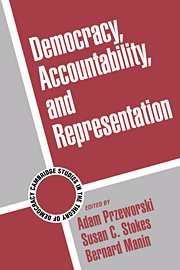Book contents
- Frontmatter
- Contents
- List of Contributors
- Introduction
- Part One Elections, Accountability, and Representation
- Part Two The Structure of Government and Accountability
- 8 Accountability in Athenian Politics
- 9 Government Accountability in Parliamentary Democracy
- 10 Mixing Elected and Nonelected Officials in Democratic Policy Making: Fundamentals of Accountability and Responsibility
- Part Three Overview
- Author Index
- Subject Index
10 - Mixing Elected and Nonelected Officials in Democratic Policy Making: Fundamentals of Accountability and Responsibility
Published online by Cambridge University Press: 05 June 2012
- Frontmatter
- Contents
- List of Contributors
- Introduction
- Part One Elections, Accountability, and Representation
- Part Two The Structure of Government and Accountability
- 8 Accountability in Athenian Politics
- 9 Government Accountability in Parliamentary Democracy
- 10 Mixing Elected and Nonelected Officials in Democratic Policy Making: Fundamentals of Accountability and Responsibility
- Part Three Overview
- Author Index
- Subject Index
Summary
This study focuses on one part of the principal-agent relationship in democratic governments, that of department heads, who are usually career officials, and their elected principals, in this case ministers in the Australian commonwealth government. It does not consider the dual role in which most elected and career officials find themselves, that of principal in some aspects of their position, and that of agent in others. Nor does it examine any of the multitude of principal-agent relationships that ultimately seek to tie the street-level public servant to the policy preferences of the electorate. It seeks expanded understanding of the way that public bureaucracies respond to elected officials' policy preferences.
Many scholars note the increasing size, function, and power of public bureaucracies during the past century (Crenson and Rourke 1987; Weber 1958; Wilson 1978). The bureaucracy's growth in power poses important problems in a democracy because it creates the possibility that unelected officials can decisively impact policy, potentially in ways that disregard public preferences. This, in turn, makes the task of elected officials of especial importance since they must oversee the bureaucracy, infuse it with democratic preferences, and make it accountable to democratic processes. Many scholars have thus studied the relationship between the two (Gaus 1936; Hyneman 1950; Laver and Shepsle 1994; Michaels 1995; Redford 1969; Wood and Waterman 1994; Worsham and Ringquist 1994). Despite this attention, neither organization theory nor democratic theory provides consensus on what Aberbach and Rockman call the proper “mesh” of elected and unelected officials in “an optimal mix” (Aberbach and Rockman 1988: 606).
- Type
- Chapter
- Information
- Democracy, Accountability, and Representation , pp. 297 - 326Publisher: Cambridge University PressPrint publication year: 1999
- 9
- Cited by



